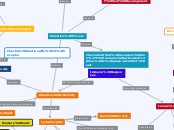Immune Responses
Adaptive Immunity
Lymphocytes
Selection Process
Checks that receptors don't become activated due to presence of self
B Cell Development
Positive Selection
Immature to Mature B Cell
Secondary Lymphoid Organ
B Cell Follicle
FDC's
Positive life signal, otherwise die in 3 days
No Receptor Editing
Negative Selection
Immature B Cell
Bone Marrow
B cells that bind soluble antigens within bone marrow
Any in bone marrow
Receptor Editing!
If responds to self cells: either apoptosis
T Cell Development
Positive Selection
Double Positive
Thymus
Cortex
Thymic Epithelial Cells
No receptor editing
Recognize self MHC
Dies
Lives
Negative Selection
Double Positive
Thymus
Throughout thymus, mostly corticomedullary junction and medulla
Any in thymus, DCs, macrophages
Receptor Editing!
MHC present self antigen
Lives
Dies
Innate Immunity
Generalized/ Nonspecific
Response to wide array of antigens
Inflammation
Calor
Increased heat up regulates immune response
Rubor
More cells into area of need
Dolor
Foreign invader notice
Tumor
Fluid enters site to attack pathogen
Pathogen Recognition
Receptors (PRR)
4 different types
and functions
Free receptors in
serum
Sense intracellular pathogens and
initiate inflammatory response
Membrane bound
phagocytic receptors
Sense potential pathogens
and initiate inflammatory response
Membrane bound
signaling receptors
Stimulate phagocytosis
Cytoplasmic signaling
receptors
Lysis, opsonization,
inflammation
Bone marrow stem cells
B-Lymphocyte
Bone Marrow
Plasma Cells
Activation of B cell
Cross-link Antigen
CR2
CD3
antigen
B cell
CD40
MHC II
alpha-1
beta-1
Length Unrestricted
More than 10 amino acids
MHC I
Size Restriction
8-10 Amino Acids
alpha-1
alpha-2
Anchor Residues
Which peptides bound to MHC
Memory Cell
Plasma Cell
Affinity Maturation
Centroblasts
Somatic Hypermutation
Point Mutations
FDC's
Selection
Isotype Switching
T Cells
Centrocytes
Germinal Center
Positively selected B cell
affinity for antigen
T cell Help
B cell cross linking
Plasma Cells
Memory cell
Negatively selected B cell
Apoptosis
T cell
Cytokines IL-4, IL-5, and IL-6
CD40 Ligand
Surface
Natural Killer Cells
T-Lymphocyte
APCs
Antigen
Macrophages
Clonal Expansion of Naive T Cells
Activation
MHC to TCR
Survival
CD28-B7
Differentiation
Cytokines tell cell what to turn into
Memory Cells
Helper T Cells
Cytotoxic T Cells
Activation of T Cell
Inflammatory Response
Activates macrophages and Dendritics
Processes MHC II
Secondary Lymphoid Tissue
CD40L: CD40
CD28: B7
IL2 binds to IL-2R
Proliferate
CD28: B7
Anergent
Lymphoid Tissues
T Cell Trafficking
Rolling
Selectins
L-selectin
Activation
Chemokines
CCL21
Adhesion
Integrins
LFA-1
Diapedesis
Chemokines
CCL21 and CXL12
Clonal Selection Theory
Clones
Enters Circulation
Short-lived effector cells
Long-lived memory cells
Thymus
Dendritic Cells
Bone Marrow
Antibodies
bind to antigen and remove it
Recruitment
Opsonization
Coating of a pathogen by antibodies so phagocytic cells can destroy it
Direct lysis of pathogen
Lectin
Manose Binding Lectin
C4b2a
Classical
C1
C4b2a3b
Alternative
C3bBb
C3bBb3b
C3b (from other pathways)
Complement Cascade
CD4 T Cells
Generation of Diversity
B-Cell Development
Heavy chain
Early pre-B to large pre-B cell stage
Bone marrow
Lambda 5, VproB
Light chain
Bone marrow
Small pre-B cell stage
Many rearrangements
Immature B
Do light and heavy chain produce functional binding site?
2 Rearrangements
2 (4 if counting DJ and VD separately
Large pre-B
Is chain funtional?
Checks functionality of receptor
T-Cell Development
Beta chain
DN2
pTalpha
Thymus
Alpha Chain
Rearrange multiple times
DN4 to DP
Thymus
2 on each chromosome
Ways to Activate
Dendritic Cells
B7 activates CD8 T Cell
CD4 T Cell
APC
B7 and IL-2 to activate CD8 T Cell
CD4 T Cell
IL-2
CD8 to proliferate
Types
CD8 Cytotoxic T cells
Kill virally infected cells
CD4 TH1
Activate infected macrophages and help B cells in antibody production
CD4 TH2
Parasitic and allergies. Helps B cells produce antibodies
CD4 TH17
Enhance neutrophil response. Promote barrier integrity
TFH
Help isotype switching of B cells
T Reg
Inhibits immature dendritic cells
